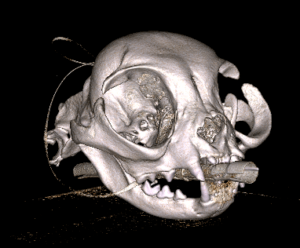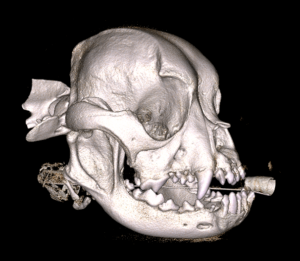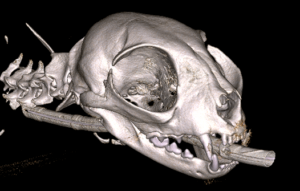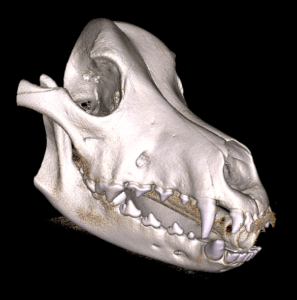
06 Nov Brachy… what?? Demystifying the different skull shapes of dogs (and cats)
Unlike people who have a relatively standard size and shape to the skull, we have bred dogs to have a wide variety of skull shapes and sizes. From our short-nosed friends like pugs and bulldogs to long-nosed pals like greyhounds and dachshunds, each skull shape comes with their own challenges and concerns. We’ll help you identify the different skull shapes of dogs. What shape skull does your dog have?
Brachycephalics (pronounced Bray-kee-suh-fal-icks)
Brachycephalic is a term used to describe animals with shorter than average skulls and flat, broad faces. Common examples of breeds that fall into this category include pugs, bulldogs, shih tzus and boxers. These dogs often have a class II malocclusion (also known as an underbite) and may have crowding or rotation of their teeth. These dogs usually have the same number of teeth as other dogs but have much less room for them in their mouth, which predisposes them to periodontal disease and buildup of plaque and calculus. Similar problems are common among brachycephalic cats – such as Persians, Himalayans and Burmese.

Image A: brachycephalic cat

Image B: brachycephalic dog
Mesocephalics (pronounced Mee-zo-suh-fal-icks)
Mesocephalic dog breeds include Labrador Retrievers, German Shepherds, Beagles and Corgis. These are dogs with an average muzzle length – not too long or too short. Of all skull shapes, these are the dogs who tend to have fewer periodontal problems. Many of these breeds, however, do tend to be aggressive chewers and may be more likely to fracture teeth. As with any dog, do not give hard bones, antlers or nylon toys to chew on! These dogs still benefit from annual dental examination and cleaning.

Image C: mesocephalic cat

Image D: mesocephalic dog
Dolichocephalics (pronounced Doh-lick-oh-suh-fal-icks)
Long-nosed dogs like Greyhounds, Borzois and Collies are considered dolichocephalics. These dogs are more susceptible to fungal disease in the nose such as aspergillosis and certain nasal tumors. Sometimes when a dog has severe periodontal disease, the bone between the roots of the teeth and the nasal cavity can be destroyed, which leads to snuffling, sneezing and nasal discharge. This is called an oronasal fistula. For this reason, it is important to evaluate the teeth if a dog shows signs of nasal disease. Studies have shown that dachshunds are particularly prone to oronasal fistulas at the site of their upper canine teeth.

Image E: Dolichocephalic dog
Don’t forget about the Kitties!
Although most people think that cats have a fairly standard skull shape, purebred cat breeds do come with a variety of skull types. The most famous, perhaps, is the Persian, which is a classic example of a brachycephalic cat. Other examples of brachycephalic cats include the Chinchilla cat and the Himalayan cat. The Oriental Shorthair, Abyssinian and Siamese are considered dolichocephalic cat breeds.
Great! I know what shape my dog’s skull is. Now what?
Your pet’s Veterinary Dentist™ can discuss your pet’s specific dental needs and risk factors and advise on any dental or oral treatment your pet needs. They can also help you develop an at-home dental hygiene protocol that works for you and your pet to keep your pet’s mouth as healthy as possible.
Image by Steshka Willems from Pexels



